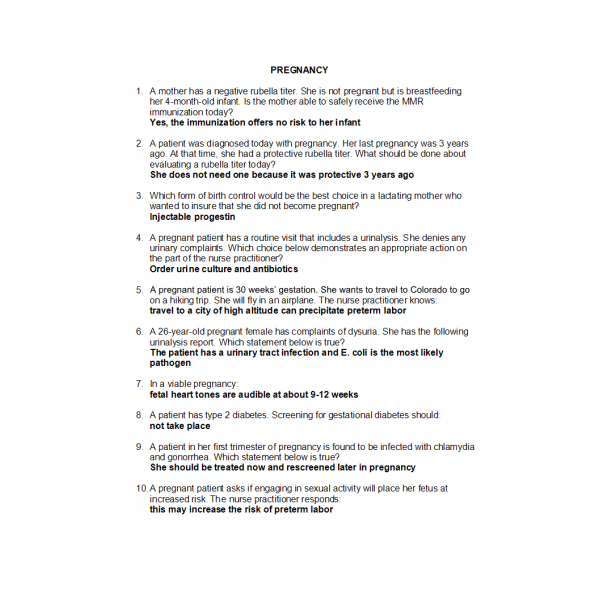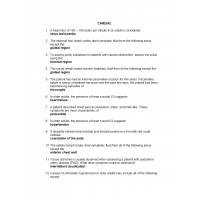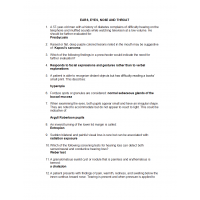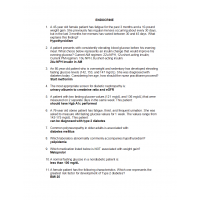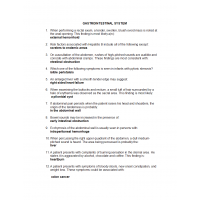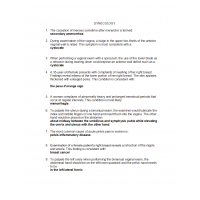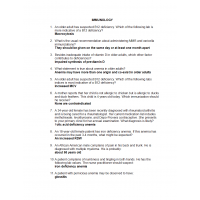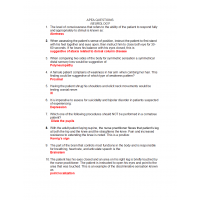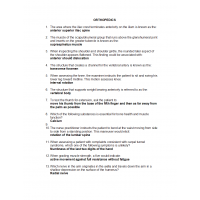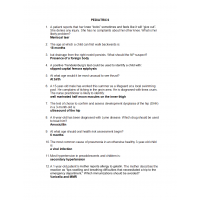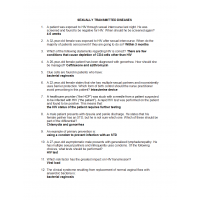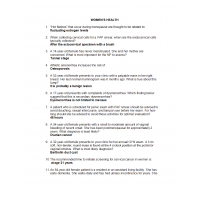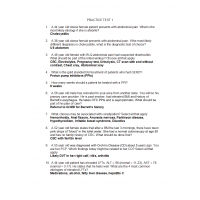NSG 6440 APEA Exam - PREGNANCY
NSG 6440 APEA Exam PREGNANCY
1. A mother has a negative rubella titer. She is not pregnant but is breastfeeding her 4-month-old infant. Is the mother able to safely receive the MMR immunization today?
2. A patient was diagnosed today with pregnancy. Her last pregnancy was 3 years ago. At that time, she had a protective rubella titer. What should be done about evaluating a rubella titer today?
3. Which form of birth control would be the best choice in a lactating mother who wanted to insure that she did not become pregnant?
4. A pregnant patient has a routine visit that includes a urinalysis. She denies any urinary complaints. Which choice below demonstrates an appropriate action on the part of the nurse practitioner?
5. A pregnant patient is 30 weeks’ gestation. She wants to travel to Colorado to go on a hiking trip. She will fly in an airplane. The nurse practitioner knows:
6. A 26-year-old pregnant female has complaints of dysuria. She has the following urinalysis report. Which statement below is true?
7. In a viable pregnancy:
8. A patient has type 2 diabetes. Screening for gestational diabetes should:
9. A patient in her first trimester of pregnancy is found to be infected with chlamydia and gonorrhea. Which statement below is true?
10. A pregnant patient asks if engaging in sexual activity will place her fetus at increased risk. The nurse practitioner responds:
11. A pregnant patient, in her first trimester, is found to have a urinary tract infection. What is the appropriate course of action?
12. The need for thyroid replacement during pregnancy:
13. The classic symptoms of an ectopic pregnancy are:
14. In order to establish pregnancy, a pregnancy test of the urine or blood is routinely performed. How early can this be done with reliable results?
15. A pregnant patient has asymptomatic bacteriuria. What is the likely pathogen?
16. You have been asked to manage thyroid disease in a pregnant patient. A pregnancy patient took levothyroxine prior to becoming pregnant. what should be done about the levothyroxine now that she is pregnant?
17. The Centers for Disease Control and Prevention (CDC) recommends Tdap for every pregnant woman. When should this vaccine be administered?
18. A 17-year-old female is found to be pregnant. What is the LEAST likely risk to her fetus?
19. A 30-year-old female presents with lower abdominal pain. The nurse practitioner immediately considers an ectopic pregnancy as the cause. Which factor listed below does NOT increase her risk of an ectopic pregnancy?
20. Naegele’s rule is calculated by adding 7 days to the last menstrual period and:
21. Which factor below confers the lowest risk of ectopic pregnancy?
22. HIV screening during pregnancy:
23. A pregnant patient in her second trimester enters your clinic in October to inquire about the influenza vaccination. Which immunization below may be safely administered?
24. A pregnant patient in her first trimester is found to have chlamydia. How should this be managed?
25. Ultrasounds are commonly performed during the first trimester of pregnancy because they help estimate gestational age and:
26. Routine screening for gestational diabetes:
27. A 17-year-old female is found to be pregnant. What is the most important part of her initial screening?
28. The NP suspects that a pregnant patient may have been physically abused by a domestic partner. The NP knows that:
29. What component of a prenatal vitamin is intended to prevent neural tube defects?
30. A 19-year-old pregnant female has the following urinalysis report. Which statement below is true?
31. Which factor listed below increases the risk of ectopic pregnancy?
32. A pregnant patient asks why she must take calcium during pregnancy. The nurse practitioner replies that it:
33. A pregnant patient complains of urinary frequency and dysuria. A urinalysis was obtained. What course of action is most appropriate?
34. Few pregnant patients actually deliver on their due dates. Why is a due date established?
35. The most effective way to decrease the incidence of spina bifida in pregnant patients is to:
36. The most effective way to decrease neural tube defects is to prescribe folic acid. For a woman with normal risks, how much is needed daily prior to becoming pregnant?
37. When should folic acid be initiated in a female patient contemplating pregnancy if she is not taking it at this time?
38. Which activity does NOT place the pregnant patient at risk of contracting toxoplasmosis?
39. A patient in her first trimester of pregnancy is found to have gonorrhea. Which statement below is true?
40. A patient has a positive pregnancy test that she performed from an over-the-counter kit. It has been 6 weeks since her last menstrual period. What are they chances that she is pregnant?
41. A pregnant patient complains of lower extremity edema and asks for a “fluid pill”. The NP explains that:
42. Which immunization(s) may be safely given during the third trimester of pregnancy?
43. Which of the following immunizations may be safely administered during the first trimester of pregnancy?
44. A 24-year-old patient presents to your clinic with intermittent nausea and vomiting for the past 5 days. She feels well otherwise. What should the nurse practitioner order initially?
45. A patient who is found to be pregnant has asymptomatic bacteriuria. How should this be managed?
46. A pregnant teenager asks if sexual activity is safe during pregnancy. The nurse practitioner responds:
47. Persistent, intractable vomiting during pregnancy is:
48. Which of the following is indicative of changes that occur in the second trimester of pregnancy?
49. The classic presentation of placenta previa is:
50. A patient has a positive pregnancy test that she performed using an over-the-counter kit. What are the changes that a serum pregnancy test will be negative?
51. A pregnant patient is in her first trimester in October. How should a flu immunization be handled for her?
52. A pregnant patient in her second trimester is found to have positive leukocytes and positive nitrites in a second voided urine specimen. She is asymptomatic. This patient should be prescribed:
53. Hyperemesis gravidarum is:
54. When do clinical manifestations of an ectopic (fallopian tube) pregnancy typically appear?
55. A pregnant patient with urinary frequency is found to have a UTI. The most appropriate treatment choice for this patient is:
56. a pregnant patient in her second trimester will probably have a decrease in her: blood pressure
58. in order to establish pregnancy, a pregnancy test of the urine or blood is routinely performed. This test assesses for:
59. A 24-year-old pregnant patient has a TSH performed. The most likely reason for this is because:
60. The rubella vaccine is contraindicated in pregnant women because:
61. A patient with an ectopic pregnancy:
62. A mother who is being counseled preconceptually is found to have a negative rubella titer. If she is immunized today, for how long should she avoid pregnancy?
63. A pregnant patient is likely to have:
64. A 30-year-old with Type I diabetes has become pregnant. The routine diabetic screening:
| Institution & Term/Date | |
| Term/Date | South University |
-
$25.00

